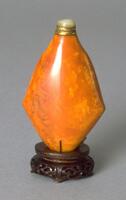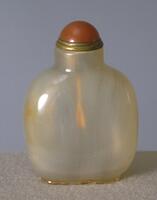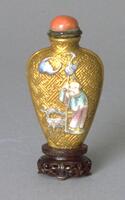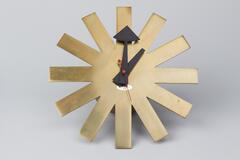12 UMMA Objects
12 UMMA Objects

Chinese (Chinese (culture or style))
Baltic amber snuff bottle
1880 – 1940
Gift of Mr. Robert W. Coggan
1980/2.92

Chinese (Chinese (culture or style))
Snuff bottle in the shape of a vase, with stylized floral patterns
1825 – 1900
Gift of Mr. Robert W. Coggan
1980/2.130

Chinese (Chinese (culture or style))
Snuff bottle with red peony design on black ground
1890 – 1930
Gift of Mr. Robert W. Coggan
1980/2.103
![This type of bowl, with an inverted rim and hollow inside, is known as an <em>okbari</em> or <em>omok-bansanggi</em> (concave tableware). Considering its size, it was probably used for serving steamed rice. The tall foot was made separately before being attached. One line is incised around the outer rim of the bowl, which gently slopes inwards. The nipple-shaped handle is fixed to the top of the lid by a nail. The head of a nail joining the foot to the base of the bowl is visible on the indented base of the foot.
<p>[Korean Collection, University of Michigan Museum of Art (2017), 249]</p>
This type of bowl, with an inverted rim and hollow inside, is known as an <em>okbari</em> or <em>omok-bansanggi</em> (concave tableware). Considering its size, it was probably used for serving steamed rice. The tall foot was made separately before being attached. One line is incised around the outer rim of the bowl, which gently slopes inwards. The nipple-shaped handle is fixed to the top of the lid by a nail. The head of a nail joining the foot to the base of the bowl is visible on the indented base of the foot.
<p>[Korean Collection, University of Michigan Museum of Art (2017), 249]</p>](/media/W1siZiIsIjIwMjIvMDkvMjQvMXltYnU1bTZzOV9kZWZhdWx0LmpwZyJdLFsicCIsInRodW1iIiwiMjQweDIwMCJdXQ?sha=209b642fb884c3d4)
Korean (Korean (culture or style))
Covered Bowl
1900 – 1950
Gift of Bruce and Inta Hasenkamp and Museum purchase made possible by Elder and Mrs. Sang-Yong Nam
2004/1.304A&B

Chinese (Chinese (culture or style))
Agate snuff bottle
1750 – 1850
Gift of Mr. Robert W. Coggan
1980/2.19
![Brass is an alloy of copper and tin. Brassware objects generally include ritual bowls, tableware for aristocrats, incense burners, braziers, and spoons. The UMMA collection does not include a complete set of dining or ritual implements but individual items including four water bowls (daejeop ), five rice bowls (jubal ), seven kimchi bowls (bosigi ), six side-dish bowls (jaengcheop ), one sauce dish (jongji ), and four spoons. It is assumed that these items were produced during the modern era. All of them were formerly part of the Bruce Hasenkamp collection.
<p>[Korean Collection, University of Michigan Museum of Art (2017), 248]</p>
<br />
Brass is an alloy of copper and tin. Brassware objects generally include ritual bowls, tableware for aristocrats, incense burners, braziers, and spoons. The UMMA collection does not include a complete set of dining or ritual implements but individual items including four water bowls (daejeop ), five rice bowls (jubal ), seven kimchi bowls (bosigi ), six side-dish bowls (jaengcheop ), one sauce dish (jongji ), and four spoons. It is assumed that these items were produced during the modern era. All of them were formerly part of the Bruce Hasenkamp collection.
<p>[Korean Collection, University of Michigan Museum of Art (2017), 248]</p>
<br />
](/media/W1siZiIsIjIwMjIvMDkvMjQvM3RvbXE5and4cF9kZWZhdWx0LmpwZyJdLFsicCIsInRodW1iIiwiMjQweDIwMCJdXQ?sha=4034804ce01bdb91)
Korean (Korean (culture or style))
Brass Serving Spoon (one of a pair)
1900 – 1950
Gift of Bruce and Inta Hasenkamp and Museum purchase made possible by Elder and Mrs. Sang-Yong Nam
2004/1.306.1

Chinese (Chinese (culture or style))
Snuff bottle adorned with symbols of longevity
1796 – 1850
Gift of Mr. Robert W. Coggan
1980/2.104
![This rice bowl, or <em>jubal</em>, has a flat base. Normally, such rice bowls are classified into three different sizes: large, medium-sized and small. Their shapes are almost identical.<br />
<p>[Korean Collection, University of Michigan Museum of Art (2017) p. 250]</p>
This rice bowl, or <em>jubal</em>, has a flat base. Normally, such rice bowls are classified into three different sizes: large, medium-sized and small. Their shapes are almost identical.<br />
<p>[Korean Collection, University of Michigan Museum of Art (2017) p. 250]</p>](/media/W1siZiIsIjIwMjIvMDkvMjQvNGd1ZWVranRqeV9kZWZhdWx0LmpwZyJdLFsicCIsInRodW1iIiwiMjQweDIwMCJdXQ?sha=543e203bee500732)
Korean (Korean (culture or style))
Bowl
1900 – 1950
Gift of Bruce and Inta Hasenkamp and Museum purchase made possible by Elder and Mrs. Sang-Yong Nam
2004/1.305
![These are <em>jubal</em>, a type of bowl used for serving steamed rice and often also called a <em>sabal</em>. The upper surfaces of the lids of these bowls are decorated with incised lines. Their bases are flat, without feet. The shapes of bowls follow regional characteristics. In northern provinces, rims curve inwards, and bowls are relatively short. In southern provinces, the walls stand almost straight, while bowls themselves are relatively tall.
<p>[Korean Collection, University of Michigan Museum of Art (2017) p. 249]</p>
These are <em>jubal</em>, a type of bowl used for serving steamed rice and often also called a <em>sabal</em>. The upper surfaces of the lids of these bowls are decorated with incised lines. Their bases are flat, without feet. The shapes of bowls follow regional characteristics. In northern provinces, rims curve inwards, and bowls are relatively short. In southern provinces, the walls stand almost straight, while bowls themselves are relatively tall.
<p>[Korean Collection, University of Michigan Museum of Art (2017) p. 249]</p>](/media/W1siZiIsIjIwMjIvMDkvMjQvNWdrMzM0dmdwZ19kZWZhdWx0LmpwZyJdLFsicCIsInRodW1iIiwiMjQweDIwMCJdXQ?sha=bb795a8a215e867a)
Korean (Korean (culture or style))
Covered Brass Bowl with Incised Circles
1900 – 1950
Gift of Bruce and Inta Hasenkamp and Museum purchase made possible by Elder and Mrs. Sang-Yong Nam
2004/1.308A&B
![These are <em>jubal</em>, a type of bowl used for serving steamed rice and often also called a <em>sabal</em>. The upper surfaces of the lids of these bowls are decorated with incised lines. Their bases are flat, without feet. The shapes of bowls follow regional characteristics. In northern provinces, rims curve inwards, and bowls are relatively short. In southern provinces, the walls stand almost straight, while bowls themselves are relatively tall.<br />
<p>[Korean Collection, University of Michigan Museum of Art (2017) p. 249]</p>
These are <em>jubal</em>, a type of bowl used for serving steamed rice and often also called a <em>sabal</em>. The upper surfaces of the lids of these bowls are decorated with incised lines. Their bases are flat, without feet. The shapes of bowls follow regional characteristics. In northern provinces, rims curve inwards, and bowls are relatively short. In southern provinces, the walls stand almost straight, while bowls themselves are relatively tall.<br />
<p>[Korean Collection, University of Michigan Museum of Art (2017) p. 249]</p>](/media/W1siZiIsIjIwMjIvMDkvMjQvOHQ3OWliOTA3NF9kZWZhdWx0LmpwZyJdLFsicCIsInRodW1iIiwiMjQweDIwMCJdXQ?sha=5b2e2e68d078b84c)
Korean (Korean (culture or style))
Covered Brass Bowl with Protruding Sides
1900 – 1950
Gift of Bruce and Inta Hasenkamp and Museum purchase made possible by Elder and Mrs. Sang-Yong Nam
2004/1.307A&B

Chinese (Chinese (culture or style))
Snuff bottle with overglaze enamel painted scene of a family in a garden
1825 – 1900
Gift of Mr. Robert W. Coggan
1980/2.102

George Nelson (American (North American))
2213 (Asterisk)
1948 – 1958
Gift of Dr. Seymour and Barbara K. Adelson
2015/2.9
Loading…
